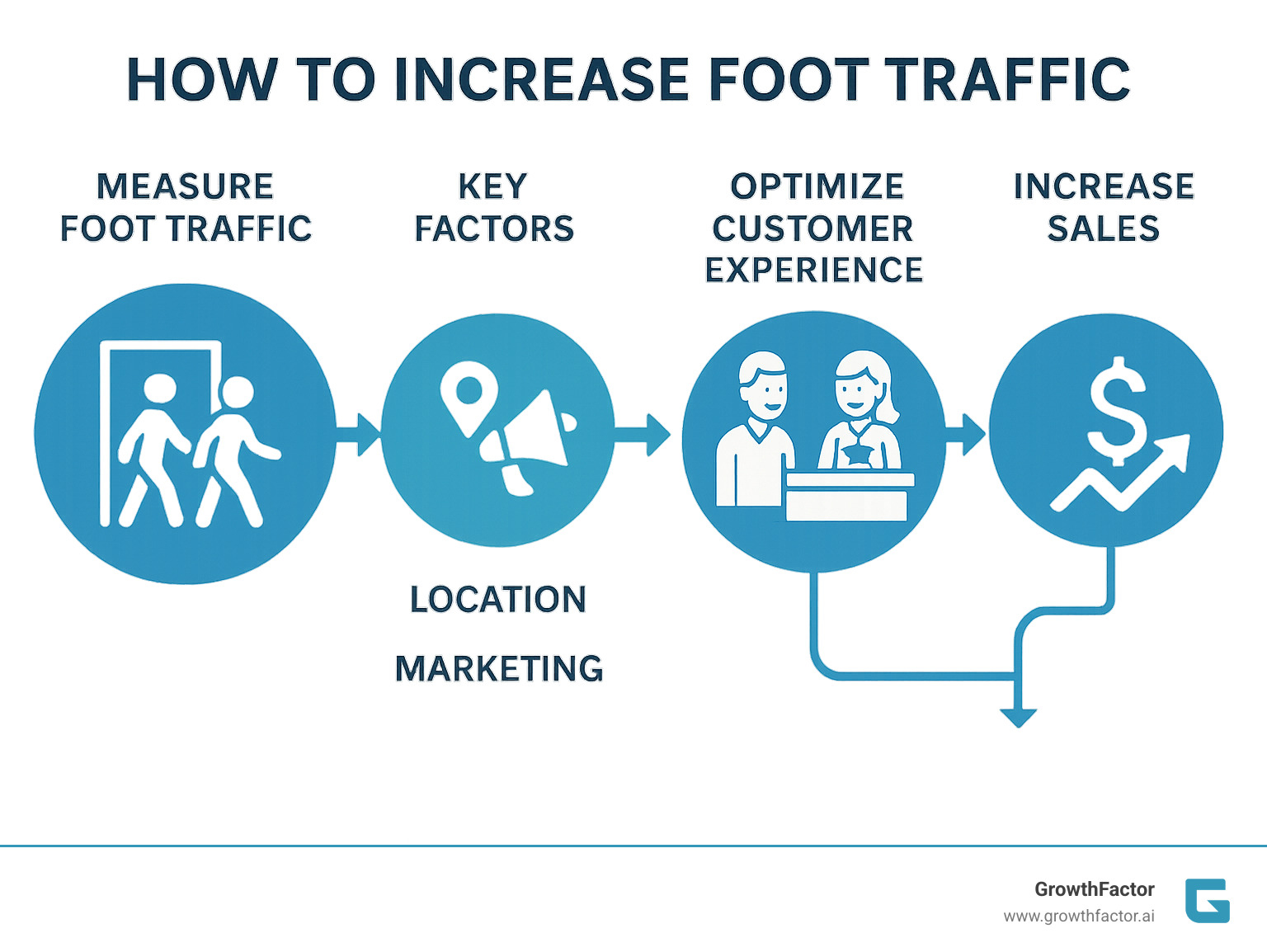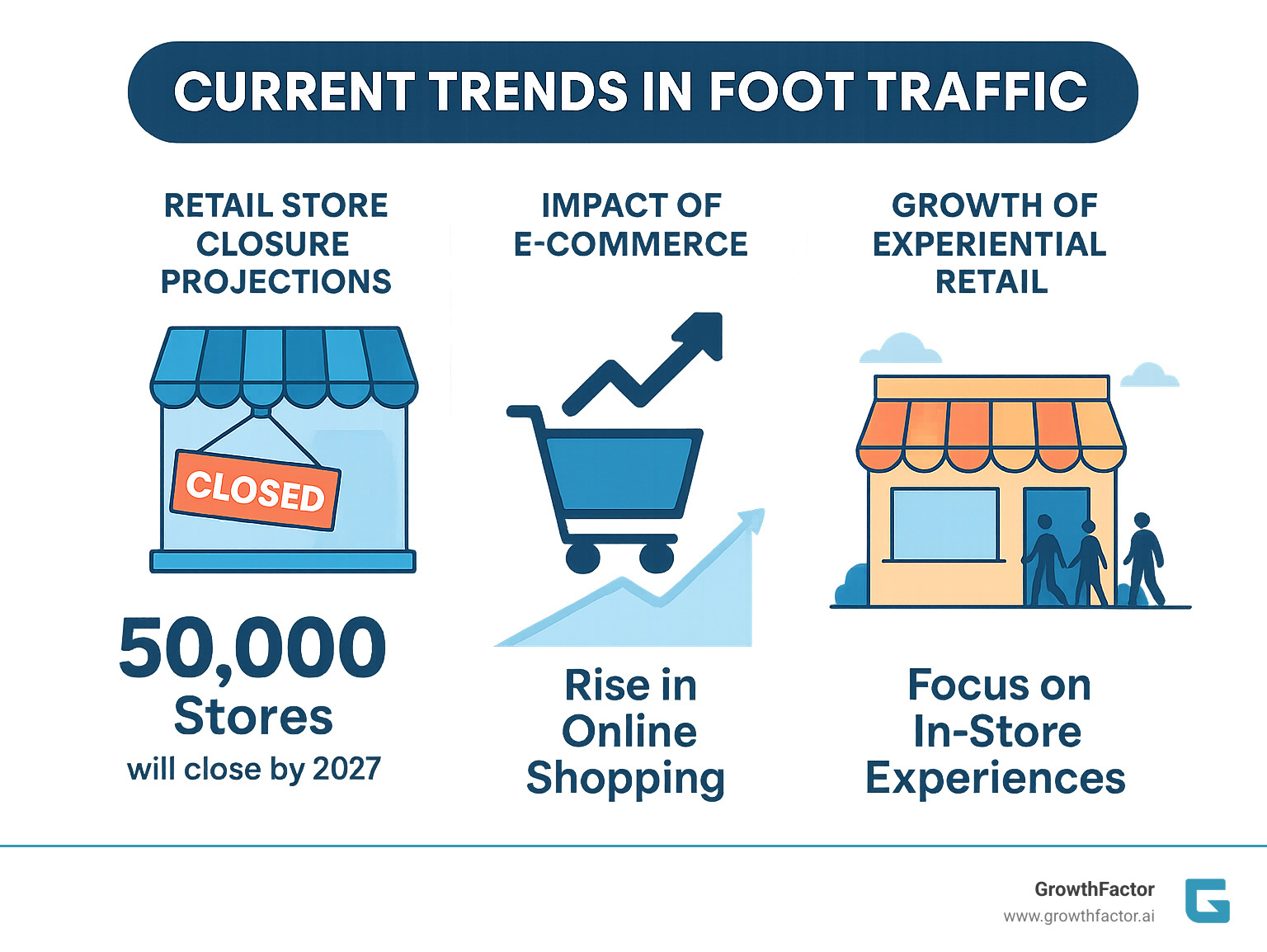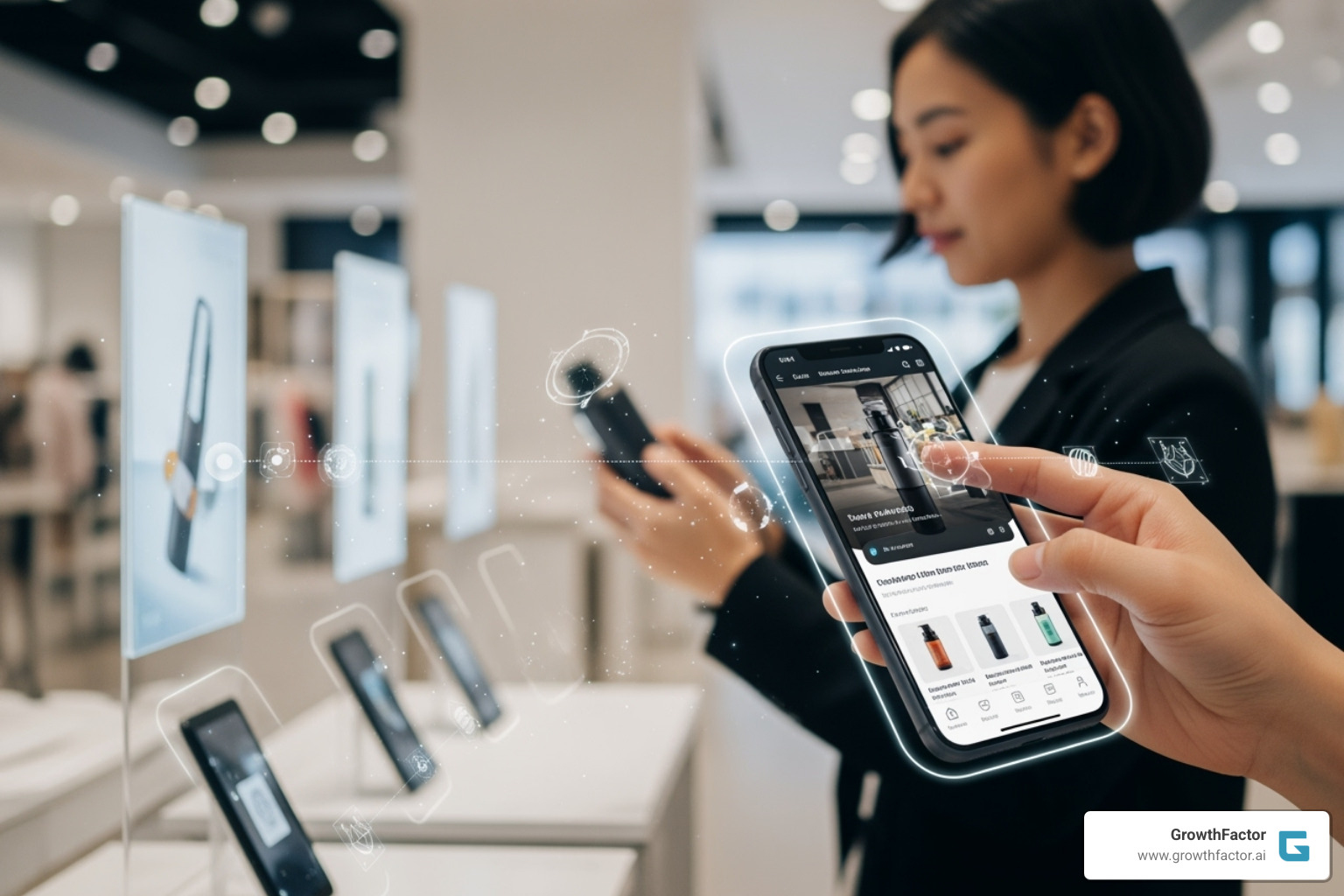How to Increase Foot Traffic
Why Foot Traffic is the Lifeblood of Your Business
Foot traffic refers to the number of people who visit a physical business location. Understanding this metric is crucial for any brick-and-mortar success, as it's a key performance indicator (KPI) that directly correlates with sales opportunities and revenue. An easy way to think about it is that more visitors usually equals more chances to sell.
Quick Definition:
- Foot traffic = Number of people entering your store.
- Footfall = UK term for the same concept).
- Key difference: Foot traffic measures actual visitors, not just passersby.
- Why it matters: Higher foot traffic typically leads to higher sales.
Research shows that foot traffic data can predict revenue performance for many brands, making it essential for strategic decision-making. The challenge lies in measuring, analyzing, and increasing this vital metric in today's competitive retail landscape.
Recent data reveals significant shifts in foot traffic patterns. The COVID-19 pandemic caused foot traffic to fall by as much as 45% in April 2020, while UBS forecasts that 50,000 retail outlets will close by 2027 due to e-commerce growth. Despite these challenges, retailers are finding success through data-driven, experience-focused strategies.
As the Founder and CEO of GrowthFactor.ai, I've seen how understanding and leveraging foot traffic data can transform business performance through strategic site selection and location intelligence.

The Ultimate Guide to Measuring, Analyzing, and Increasing Foot Traffic
Optimizing foot traffic is a necessity for survival and growth in modern retail. It's not just about counting heads, but about gleaning deep insights into customer behavior, market trends, and competitive landscapes. Leveraging advanced data analysis and business strategy helps businesses make smarter decisions and adapt to evolving trends. Learn how we use AI for location intelligence to provide a competitive edge. More info about AI Location Intelligence.

How to Measure and Track Foot Traffic
Measuring foot traffic has evolved from manual methods to sophisticated data science. Historically, foot traffic was measured with clickers or observation, methods that lacked accuracy and scalability. Today, digital tools provide more accurate and insightful ways to track this metric:
- Electronic Sensors: Infrared, thermal, and stereo depth cameras count people with high accuracy.
- Wi-Fi and Bluetooth Analytics: Anonymously track device movement to measure dwell time, repeat visits, and in-store paths.
- GPS Data from Smartphones: Aggregated and anonymized GPS data offers a powerful, comprehensive view of visitor origins (trade areas) and broader mobility patterns.
- Data-as-a-Service (DaaS): DaaS providers offer aggregated mobile data for detailed, privacy-compliant consumer analysis.
- AI and Facial Recognition: AI-powered video analysis can identify demographics and track movement, but requires strict adherence to privacy regulations like GDPR and CCPA.
- POS System Integration: Integrating foot traffic counters with POS systems allows businesses to calculate conversion rates and link traffic directly to sales.
Measuring foot traffic helps determine optimal locations, assess marketing campaigns, and optimize store layouts. Learn more in our guide to More info about Store Location Analytics.
Here's a quick comparison of manual versus digital tracking methods:
| Feature | Manual Tracking (Clickers, Observation) | Digital Tracking (Wi-Fi, GPS, AI Cameras) |
|---|---|---|
| Accuracy | Low to Moderate (human error) | High (consistent, precise) |
| Cost | Low initial, high labor cost | Higher initial investment |
| Scalability | Very Low | High (multi-location, real-time) |
| Data Privacy | Minimal concern | High concern (requires anonymization, compliance) |
| Insights Depth | Basic counts | Rich behavioral insights (dwell time, trade areas, etc.) |
Key Factors That Influence Foot Traffic
Several critical factors influence how many people visit your business:
- Store Location: The most significant factor. Proximity to transport hubs, busy shopping centers, complementary businesses, residential areas, and offices drives traffic.
- Visibility and Curb Appeal: An inviting, visible storefront is crucial. Use eye-catching signage, well-maintained exteriors, and engaging window displays to attract passersby.
- Marketing Campaigns: Targeted advertising, local SEO, and promotions boost traffic. A strong online presence on platforms like Google My Business is essential, as many local searches lead to store visits.
- Local Events and Seasonal Factors: Local events, holidays, and seasonal trends create traffic surges, while factors like weather can deter visitors.
- Competition: The presence (or absence) of competitors and nearby anchor stores directly impacts your visitor numbers.
- Demographics and Psychographics: Locate your business where your target audience lives, works, and shops to attract the right kind of visitors.
- Store Layout and Design: An optimized internal layout with clear paths and strategic displays encourages longer visits and converts traffic into sales.
Choosing the right retail location is paramount. We dig deeper into this in our guide: More info about How to Choose Retail Location.
Proven Strategies to Increase Foot Traffic
Attracting more people requires a blend of traditional and digital tactics:
- Optimize Local SEO: Ensure your business has accurate, optimized listings on Google My Business and other local directories to capture customers searching online.
- Host In-Store Events: Draw visitors with workshops, demos, or meetups. This creates a community hub and provides a reason to visit beyond shopping.
- Create Local Partnerships: Partner with complementary local businesses for cross-promotions, joint marketing, or shared events to expand your reach.
- Leverage Social Media: Use social media to drive in-store visits through local hashtags, influencer partnerships, and promotions that require a physical visit.
- Improve Convenience with BOPIS: Offer Buy Online, Pickup In-Store (BOPIS) to bridge online and offline experiences, bringing digital customers into your physical location.
- Boost Your Curb Appeal: Make a great first impression with eye-catching signage, fresh window displays, and an inviting entrance.
- Offer Exclusive Promotions: Create urgency with limited-time offers and exclusive in-store promotions to give customers a compelling reason to visit now.
- Improve the In-Store Experience: Make the visit memorable with a clean space, helpful staff, and amenities like free Wi-Fi to encourage repeat visits.
- Adjust Staffing and Hours: Use foot traffic data to optimize staffing levels and operating hours for peak efficiency.
- Adapt to Retail Trends: Stay agile by adapting to trends like experiential shopping to maintain relevance and attract visitors.
We explore more tactics in our detailed guide: More info about High Foot Traffic.
Leveraging Data for Smarter Business Decisions
The real power of foot traffic data lies in the strategic decisions it enables:
- Site Selection: Foot traffic data is foundational for site selection. Analyze visitor counts, behavior, trade area reach, and co-tenancy to evaluate potential sites. Our AI Agent Waldo helps teams evaluate more sites efficiently by automating this process. This data also helps prevent sales cannibalization by analyzing trade area overlaps. Learn more about More info about Data-Driven Site Selection and More info about Retail Location Analysis.
- Marketing Optimization: Measure the direct impact of marketing campaigns by comparing traffic numbers before and after a promotion to assess ROI and refine future strategies.
- Staffing Schedules: Use traffic data to align staffing schedules with peak visitor hours, improving customer service and controlling labor costs.
- Inventory Management: Correlate traffic with sales data to understand product performance. High traffic with low sales in an area may signal a merchandising issue, informing inventory and placement decisions.
- Operational Efficiency: Analyze traffic flow to optimize store layout, product placement, and operational tasks like cleaning schedules.
- Customer Journey Analysis: Mobile data reveals the complete customer journey, including cross-visitation patterns. Use this to identify synergistic businesses and understand customer behavior outside your store.
- Financial Decisions and Property Valuation: In commercial real estate (CRE), foot traffic is a key indicator of revenue and property value, crucial for investment decisions, valuations, and lease negotiations.
Key challenges include ensuring data quality, maintaining strict privacy compliance, and correctly interpreting the data. High traffic doesn't guarantee high sales without good conversion rates.
Current Trends: E-commerce, COVID-19, and Experiential Retail
The landscape of foot traffic has been significantly reshaped by major trends:
- Impact of E-commerce: E-commerce has led to a decline in physical store visits. UBS forecasts 50,000 retail outlet closures by 2027 due to this shift. This signals not the end of physical retail, but a fundamental change in its role.
- Pandemic Effects: The COVID-19 pandemic caused foot traffic to plummet by up to 45% in April 2020 and shifted visitor patterns towards suburban areas.
- Post-Pandemic Recovery: Post-pandemic recovery is underway, with traffic in many urban areas and shopping malls rebounding, driven by post-holiday sales and a focus on experiential offerings.
- Experience-Shopping Strategy: The shift to "experience shopping" is a key strategy to boost traffic. Malls and retailers are adding dining, entertainment, and immersive events to transform their locations into destinations.
- Shift in Consumer Habits: Consumer habits have shifted to value convenience and social experiences. Omnichannel strategies like BOPIS are now standard, and there's growing demand for health and fitness offerings within retail spaces.

This evolving landscape means businesses must be agile, leveraging data to understand new patterns and adapting their offerings to meet changing consumer demands.
Conclusion: The Future of Foot Traffic in a Digital World

The story of foot traffic is evolving. It has transformed from simple head-counting to a complex behavioral science. The physical store is not disappearing; it's becoming a smarter, more essential experiential hub where customers can form a real human connection with a brand. This focus on experience is why many physical retail locations are seeing a revival.
AI is revolutionizing how we understand foot traffic patterns. At GrowthFactor, our AI Agent Waldo helps businesses understand who is visiting, when they're coming, and what drives their decisions, offering a level of insight previously unimaginable.
Integrating digital marketing with physical store visits creates powerful synergies. By optimizing local SEO, hosting events, and offering omnichannel experiences like BOPIS, you build lasting customer relationships. This data-driven approach is the cornerstone of modern retail strategy, informing everything from site selection to staffing and inventory.
The future belongs to businesses that blend digital intelligence with a compelling physical presence. The retail landscape will continue to change, but understanding your foot traffic is fundamental to understanding your business. With the right tools and strategies, you can turn every visitor into an opportunity.
Ready to transform your approach? Find how our all-in-one real estate platform can help you find high-traffic locations and find what's possible when data meets opportunity.
Citations
The human algorithm
Request a live demo
Schedule meeting
Or submit your information below and we'll be in touch to schedule.




